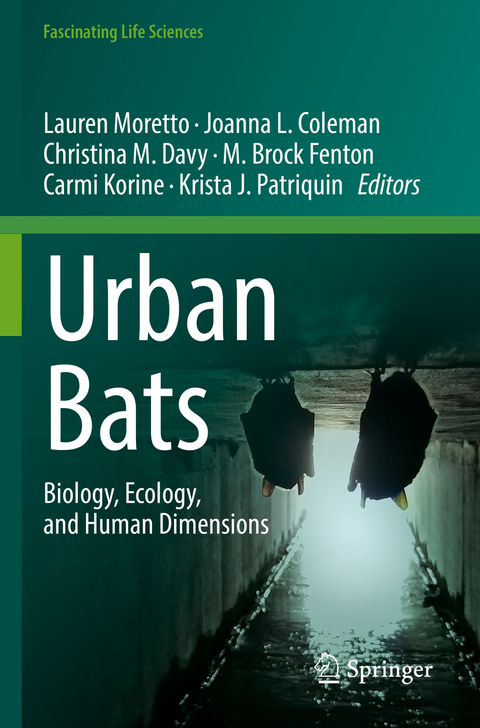
Urban Bats
Springer International Publishing (Verlag)
978-3-031-13175-2 (ISBN)
Our book explores the interactions between bats and urban environments through case studies and reviews. Understanding how different species interact with urban environments can reveal potential opportunities to mitigate urban threats to bats and threats posed by bats to other urban organisms, including humans. With this book, we thus aspire to provide a knowledge base to help guide current and future efforts to conserve bats.
Lauren Moretto is a Master of Science graduate from the Fahrig Landscape Ecology Lab in the Department of Biology at Carleton University. Lauren's general research interests are wildlife and habitat management, but she specializes in urban, bat, and landscape ecology. Joanna L. Coleman is an Assistant Professor at City University of New York-Queens College. She is also a core member of the Human Dimensions Working Group and the Co-Chair of the Bat Trade Working Group, within the IUCN Species Survival Commission, Bat Specialist Group. Her applied and interdisciplinary research agenda uses ecology and social science and to mitigate biodiversity loss and promote sustainability on an increasingly urban planet. M. Brock Fenton, Professor Emeritus at Western University in Ontario, Canada, uses bats to explore the interfaces between animal behaviour, ecology and evolution. His research involves different aspects of the biology of bats using a combination of field and laboratory experiments and observations in settings ranging from different locations in Canada to a variety of sites in the tropics and subtropics. Christina M. Davy is a Conservation Ecologist based at Carleton University, where she and her students study the impacts of rapid environmental change on endangered wildlife, including bats. She is particularly interested in understanding bats’ behavioral and genetic responses to habitat modification, including urbanisation, and the selective impacts of pathogens on bat behavior and population viability. Carmi Korine is a Professor at Ben-Gurion University of the Negev, Israel. Carmi is studying the physiological ecology of bats, a discipline that explores, in an ecological and evolutionary context, the ways in which animals function in response to their natural environments. Currently, Carmi’s research explores the effects of anthropogenic disturbances on conservation ecology of desert-dwelling bats. Krista J. Patriquin is an Adjunct Professor at Saint Mary’s University, and Research Coordinator with the Sable Island Institute, both in Nova Scotia, Canada. Broadly, her work investigates how organisms respond to change, including human-induced change. Most of this work has focused on foraging behaviour and conservation of bats in myriad environments, including urban parks.
Chapter Outlines.- Section 1: What is an Urban Bat? Morphological, Physiological, Behavioural and Genetic Adaptations.- Chapter 1: Physiological adaptation of bats to urban areas.- Chapter 2: Genetic impoverishment and species endangerment in the Anthropocene.- Chapter 3: Behavioral preadaptation of molossid bats to urban environments.- Chapter 4: The ecology of bats and their parasites in relation to urbanisation.- Chapter 5: Effect of urbanization on the social and mating system of bats.- Section 2: How do Bats Inhabit Urban Environments? Uses of Artificial Roosts, the Aerospace, and Green Spaces.- Chapter 6: Roost selection by urban bats.- Chapter 7: Bat boxes as roosting habitat in cities - 'thinking outside the box'.- Chapter 8: Woah, living in the air! Aerial habitats and aeroconservation for urban bats.- Chapter 9: What traits of greenspace in urban environments influence bat abundance and diversity?.- Chapter 10: Urban bats living in the city of Recife, Brazil.-Section 3: How do Bats and Humans Interact in Urban Environments? Human Perceptions, Public Health, and Ecosystem Services of Bats.- Chapter 11: Human dimension of bats in the city.- Chapter 12: Public health /conflicts between humans and bats.- Chapter 13: Ecosystem services of bats in urban habitats.- Chapter 14: The big picture, and moving forward with urban bat research, management, and conservation.
| Erscheinungsdatum | 06.01.2024 |
|---|---|
| Reihe/Serie | Fascinating Life Sciences |
| Zusatzinfo | X, 190 p. 31 illus., 21 illus. in color. |
| Verlagsort | Cham |
| Sprache | englisch |
| Maße | 155 x 235 mm |
| Gewicht | 311 g |
| Themenwelt | Naturwissenschaften ► Biologie ► Ökologie / Naturschutz |
| Naturwissenschaften ► Biologie ► Zoologie | |
| Schlagworte | Chirpotera • Habitats • human-modified ecosystems • Urban bats • urbanisation • wildlife management |
| ISBN-10 | 3-031-13175-4 / 3031131754 |
| ISBN-13 | 978-3-031-13175-2 / 9783031131752 |
| Zustand | Neuware |
| Haben Sie eine Frage zum Produkt? |
aus dem Bereich


